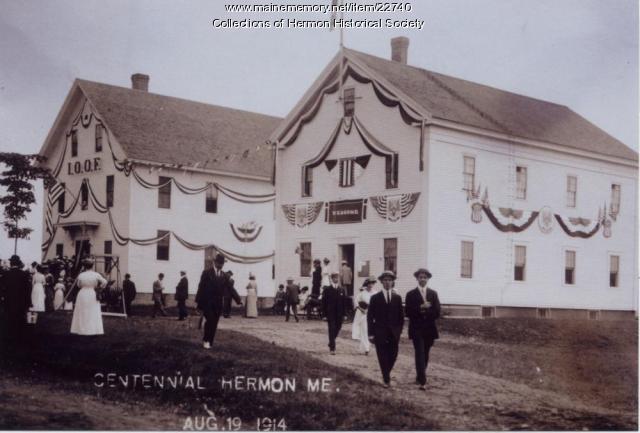Keywords: agricultural
Item 8653
Maine State Agricultural Exhibition, 1860
Contributed by: Maine Historical Society Date: 1860 Location: Portland Media: Ink on paper
Item 5493
Pembroke agricultural fair, ca. 1890
Contributed by: Maine Historical Society Date: circa 1895 Location: Pembroke Media: Photographic print
Item 148198
Opportunity Farm cow barn end framing, New Gloucester, ca. 1945
Contributed by: Maine Historical Society Date: circa 1945 Location: New Gloucester Client: Opportunity Farm Association Architect: University of Maine Cooperative Extension Work in Agriculture
Item 110485
Asticou Azalea Garden shore plan, Mount Desert, 1982-1992
Contributed by: Maine Historical Society Date: 1982–1992 Location: Mount Desert Client: The Island Foundation Architect: Patrick Chasse; Landscape Design Associates
Exhibit
Blueberries to Potatoes: Farming in Maine
Not part of the American "farm belt," Maine nonetheless has been known over the years for a few agricultural items, especially blueberries, sweet corn, potatoes, apples, chickens and dairy products.
Exhibit
The Barns of the St. John River Valley: Maine's Crowning Jewels
Maine's St. John River Valley boasts a unique architectural landscape. A number of historical factors led to the proliferation of a local architectural style, the Madawaska twin barn, as well as a number of building techniques rarely seen elsewhere. Today, these are in danger of being lost to time.
Site Page
Presque Isle: The Star City - Agriculture
"Agriculture Agriculture has always been the key component of Presque Isle's economy. Whether as the source of necessary supplies for the lumber…"
Site Page
Farmington: Franklin County's Shiretown - Agriculture
"(More about WWI Impact on Farmington's Agriculture.) 1863 Franklin Co. Agricultural Newsletter This newsletter shows the many categories for…"
Story
Eating lower on the food chain
by Avery Yale Kamila
Animal agriculture's ties to climate change
Story
Somali Bantu farmers put down roots in Maine
by Muhidin D. Libah
Running the Somali Bantu Community Association and finding food security in Maine
Lesson Plan
Teddy Roosevelt, Millie, and the Elegant Ride Companion Curriculum
Grade Level: 3-5, 6-8
Content Area: Social Studies
These lesson plans were developed by Maine Historical Society for the Seashore Trolley Museum as a companion curriculum for the historical fiction YA novel "Teddy Roosevelt, Millie, and the Elegant Ride" by Jean. M. Flahive (2019). The novel tells the story of Millie Thayer, a young girl who dreams of leaving the family farm, working in the city, and fighting for women's suffrage. Millie's life begins to change when a "flying carpet" shows up in the form of an electric trolley that cuts across her farm and when a fortune-teller predicts that Millie's path will cross that of someone famous. Suddenly, Millie finds herself caught up in events that shake the nation, Maine, and her family. The lesson plans in this companion curriculum explore a variety of topics including the history of the trolley use in early 20th century Maine, farm and rural life at the turn of the century, the story of Theodore Roosevelt and his relationship with Maine, WWI, and the flu pandemic of 1918-1920.
Lesson Plan
Building Community/Community Buildings
Grade Level: 6-8
Content Area: Social Studies
Where do people gather? What defines a community? What buildings allow people to congregate to celebrate, learn, debate, vote, and take part in all manner of community activities? Students will evaluate images and primary documents from throughout Maine’s history, and look at some of Maine’s earliest gathering spaces and organizations, and how many communities established themselves around certain types of buildings. Students will make connections between the community buildings of the past and the ways we express identity and create communities today.


















